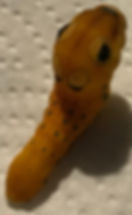Critter Spotlight: Spicebush Swallowtail: Papilio troilus
- cynthiamorissette
- Oct 19, 2021
- 2 min read
Nature is incredible. Check out this amazing little caterpillar that acts like a snake.

This is the caterpillar of the spicebush swallowtail butterfly: Papilio troilus. When disturbed the caterpillar will raise up its head like a cobra. It is also equipped with something known as an osmeterium. This is an organ that comes out of the prothoracic segment, which is the first segment on the insect's thorax. It looks like two tongues and emits a very foul odor. This is known as a defense mechanism. By extending the osmeterium, the caterpillar looks dangerous to predators, not to mention that the odor that is produced is so foul that creatures wouldn't want to stick around. To see how this works, check out the video on the left, below the picture.
You will notice that in the video, the caterpillar is green, and in the photo above, the caterpillar is orange. My oldest daughter found the orange caterpillar above, and after researching the spicebush, we discovered that the caterpillar changes to orange in its last instar, this is the stage right before it builds its chrysalis.
Spicebush swallowtails go through complete metamorphosis. They start as an egg. Eggs take 4-10 days to hatch. The larva which emerges sheds or molts 4-5 times and will be in this stage for 3-4 weeks. The larva will turn orange, create a chrysalis, and stay as a chrysalis for 10-20 days, except for those species which overwinter, their pupa stage is longer. Once the spicebush butterfly appears, it will live for 2-14 days.
Spicebush caterpillars and butterflies can be found in yards, swamps, woodlands, fields, and parks. Larva feed on spicebush, sassafras, red bay, and sweet bay leaves. Adults sip nectar.
Spicebush caterpillars in addition to having an awesome defense, also have a fantastic way to hide. These caterpillars will use silk to curl up the leaves that they are inside of so they aren't as visible to predators. Here is a picture of what that looks like.

Spicebush swallowtails are found in the Eastern sections of the United States, including Rhode Island. Keep your eyes out when you are outdoors exploring, you might just spot one!
I hope you enjoyed this critter spotlight about another one of nature's amazing creatures. If you have a suggestion for a future blog, please email Mrs. Morissette at cmorissette@narrabay.com
Happy Exploring Watershed Explorers,
Mrs. Morissette


